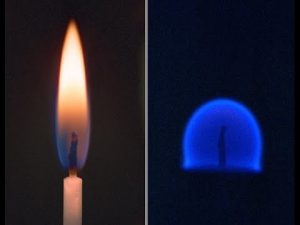We are all familiar with the appearance of a candle flame. Warm, bright yellow, and formed like a teardrop it nestles up the wick just to reach far out into the empty above it. This behavior can be easily explained by the rise – the convection – of the less dense air that is heated by the combustion around the wick. While colder, more dense air floats inward, the buoyancy of the warm air lets it move upward and away from the combustion zone. However, this process requires buoyancy, which only exists in an environment with gravity. But what would then happen to a flame in zero gravity?
In so-called microgravity, that is an environment with very little gravity like it is present in the Earth’s orbit, there is no convection since there is no definition of a classical “up and down”. The flame therefore looks significantly different and forms a light blue, spherical shape instead of the familiar teardrops. To understand this behavior, one has to consider the chemistry of the combustion as well as the physics of the gas exchange.
In case of the “normal” candle flame, the bright yellow color stems from soot particles that originate in the (non-perfect) combustion. They rise with the hot air and glow yellow in the upper region on the flame. The lower blue-ish region on the other hand is fed by the stream of fresh oxygen-rich air from below. In case of the flame in microgravity, there is no preference for up and down and therefore it assumes a spherical shape. Due to the lack of conversion, the combustion is fed only by (slow) diffusion of the oxygen into and the fuel out of the central combustion zone. This means that the zero-gravity flame burns much slower and does not produce equally distributed soot particles. Thus it is blue, spherical, and produces much more CO and formaldehyde than CO2, soot, and water.
This behavior, and how to extinguish a flame in microgravity, is under investigation aboard on the International Space Station (ISS) in the so-called FLame Extinguishment Experiment (FLEX). It is carried out on small heptane bubbles that are ignited in a controlled atmosphere. The experiment found that such small flame bubbles are not just exotic to look at, but also can pose a threat to space exploration since they can be much more difficult to extinguish. In this way, research on small bubbly flames can thus help making space exploration a bit safer.

A candle on Earth (left) and in microgravity (right): The different combustion patterns are clearly visible. [3, NASA]
— Kai Litzius
References:
[1] www.nasa.gov/mission_pages/station/research/experiments/666.html
[3] https://www.youtube.com/watch?v=DmrOzeXWxdw